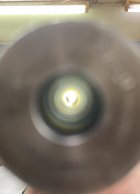What method would someone use to recognize a straight hole?
There on lies the problem.
it is easy to see the crooked areas in a barrel. All you have to do is look.
Ascertaining whether an ID of a long object is truly straight takes equipment that is quite specialized.
Every time someone says”curved” in one of these discussions, they just proved that they do not understand the problem, The term “curved” denotes a continuous parabolic shape, much like a banana. This is not what is exhibited in a barrels ID.
Since I have the means to do it, I have taken the time to actually cut a barrel into multiple 2 inch sections to show shooters exactly what is going on. It clearly showed how the ID can wander by several thousandths one way or another in what can best be described as a random pattern.
I made a detailed post explaining the entire phenomena. I posted pictures. I laid it out in a practical manner, easy to understand, and easy to see.
Very few seemed to care. They would rather listen to conjecture over on “bang-a-way.com” from someone trying to sell them something.
Most have no idea of the problems encountered in deep hole drilling of small diameter holes in long sections.
If barrel ID’s were indeed truly straight, all of this would be a moot point. But since they are what they are, Gunsmiths and Craftsmen have to get creative in figuring out what to true up to what.
As a Machinist, you look at a job like this strictly from that viewpoint of a machinist.. As most know, if you are dealing with something that is not straight, you can true any two points in it’s length to run truly straight with each other. The problems arise when you then attempt to plug in a 3d point.
So, logic dictates that you pick out two important points, true them up, and then machine that third point to run truly straight with the first two predetermined spots. You then have three points truly straight with each other.
Everything else in between, you don’t worry about.
The three points I want running true are the chamber, the throat,(described as the very first thing the bullet encounters when it leaves the case), and the muzzle.
I can do this. In fact, that is how I chamber my barrels. It takes a little bit of thought, but it is the best method I have come up with when dealing with the anomalies you encounter in the ID of a barrel.
keep in mind, I am not a Gunsmith. To me, chambering and fitting a barrel is nothing but another machining procedure with predetermined requirements and tolerances that I have to meet.
And, I check my work. In a machine shop, you do not assume things. You check it to insure that your setup is indeed viable and produced the results required.











